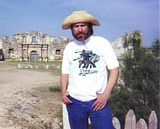Post by tmdreb on Apr 7, 2007 23:17:37 GMT -5
The biggest problem I've seen with reproduction Mexican uniforms is the pattern and construction. The body should be very short and close fitting, terminating at around the bend of the elbow. The sleeves should be rather tight, with not much of a gap around the hand. The cut of the coatee makes it impossible to wear pants cut on a modern pattern without the shirt hanging out the front. The collar should not be loose, open and floppy, but rather stand up straight and close to the neck. From behind, you should not see a wedge-shaped gap between the tails. These are problems seen on both movie extras and reenactors, due in no small part to the lack of commercial patterns and suppliers.
I'm personally of the opinion that while the shoulder wings came and went, Mexican uniform coatees from 1821-1839 were mostly blue with red piping. The 1832 uniforms were an experiment that was not continued, which is also an opinion of mine. They are obviously more complicated and expensive (requiring more wool and buttons) than the single-breasted versions. The coatees in Hero of Tampico are interesting in that they are single-breasted like the non-1832 pattern coatees, but have white piping on the tails.
I would completely agree that the white jackets are the fatigue uniform, unless the battalion is serving in a tropical area, or has nothing else to wear. I'm not personally sure if they're made of cotton, linen or hemp, as I've seen references to all three. I've also seen references to (and an 1820's illustration showing) undress blue wool jackets and frocks, but I haven't seen proof that the former existed and the latter was used in the 1830's.
For some odd reason, I've seen at least a score of 1820's illustrations of Mexican soldados, but outside of officers, the Hero of Tampico is the only 1830's illustration I've seen. Rene Chartrand makes note of one or two in his Osprey book, but did not include reproductions of the images in that work.
Phil Graf
I'm personally of the opinion that while the shoulder wings came and went, Mexican uniform coatees from 1821-1839 were mostly blue with red piping. The 1832 uniforms were an experiment that was not continued, which is also an opinion of mine. They are obviously more complicated and expensive (requiring more wool and buttons) than the single-breasted versions. The coatees in Hero of Tampico are interesting in that they are single-breasted like the non-1832 pattern coatees, but have white piping on the tails.
I would completely agree that the white jackets are the fatigue uniform, unless the battalion is serving in a tropical area, or has nothing else to wear. I'm not personally sure if they're made of cotton, linen or hemp, as I've seen references to all three. I've also seen references to (and an 1820's illustration showing) undress blue wool jackets and frocks, but I haven't seen proof that the former existed and the latter was used in the 1830's.
For some odd reason, I've seen at least a score of 1820's illustrations of Mexican soldados, but outside of officers, the Hero of Tampico is the only 1830's illustration I've seen. Rene Chartrand makes note of one or two in his Osprey book, but did not include reproductions of the images in that work.
Phil Graf






